#hairy men...(bias)
Explore tagged Tumblr posts
Text

i swear i'll draw other sdv characters besides harvey, just let me have this moment
#sdv#sdv farmer#stardew valley#sdv harvey#harvey stardew valley#my art#doodle#IK HIS BEACH SPRITE IS BASICALLY RAW CHICKEN#but...#hairy men...(bias)#stardew valley fanart#stardew fanart
664 notes
·
View notes
Note
As a bear who is into other bears, I'm apprehensive but excited about the fandom-wide adoration of Senshi's design from Dungeon Meshi. Fandom of old has a habit of framing older, heavier, hairier men as sex icons purely ironically, but the love Senshi has garnered feels... different. It feels far more sincere and any comments are at worst playful jabs. Why do you think Senshi has captured so many hearts?
Well, Senshi is a well-presented, interesting, empathetic and funny character who is portrayed really really well in the anime, that's really the core of it.
Also, a caring, attentive man who is deeply invested in his hobby and eager to tell you about it, who takes care of your needs and makes space for your eccentricities and who can also cook is the sheets-soakingly horny throbbing center of a LOT of people's erotic imagination. Dungeon Meshi presented that archetype earnestly and without ironic distance or mockery, and people responded.
It also matters a lot, I think, that the show itself takes Senshi and his physicality seriously as something interesting and worthwhile about him. I've written a post about it elsewhere, but Ryuko Kui takes character design seriously, and designs characters with a real interest in their bodies and presentation. Whether or not she meant for Senshi to be sexy, her art seems to take joy from portraying his body as something which it is worth your time to look at and appreciate.
And that's a big point of difference with how not just bear-type characters but all characters in a story are portrayed. A lot of anime treat its characters mostly as clothing racks to hang cool costumes on, and physical difference is only really employed visually as a means of abjection, a means to alienate or separate a character from the norm. Dungeon Meshi largely avoids this - in the visual language of that story, physical difference is the norm, and at least to me, that creates much more of a feeling of non-judgment about how the characters are portrayed.
So Senshi isn't stocky and hairy because ha ha eww look at the hairy man gross, he's stocky and hairy because that's a normal thing to be for him. There's a greater neutrality there, and this avoids passing bias on to the audience, and creates more space for appreciation.
... I think, anyway. I've been awake for like 20 hours and I'm loopy and this sh** is basically just off the dome in a stream of consciousness, I have no idea if any of this makes sense.
807 notes
·
View notes
Text
Playing D&D, I'm very aware I prefer creating male characters. Call it cultural bias, an aesthetic attraction to the male form, or a fascination with that kind of "men's culture" I sometimes encounter in media and conversation.
To counterbalance this, I've been scrambling to come up with female and non-binary NPCs for my homebrew and always make sure that I have a list of NPC ideas at hand that includes a surplus of female and non-binary characters. I still generally feel like I'm failing at differentiating them and integrating them into the narrative.
Well. We're almost one year into the campaign, and my players decided to do a game of Fuck, Marry, Kill with memorable NPCs. The female characters were fairly easy — Mother Morrel (a large, hairy archfey-esque creature), Sylvia the Kelpie (tried to lure the party to their death), and Alaria Va'lielmo (a fighter-druid who just wants to be autistic about her dragon birds). Most decided to kill Sylvia, and either fuck or marry Mother Morelle or Alaria.
Then we got to the male characters and they were stumped. The only one they were certain about including was Velaldel Va'lielmo (Alaria's brother, a semi-deity currently MIA). For the other two they ended up picking Grandpa Peacock (a gardener firbolg) and Vorin Treskell (a small fruit dove aaracockra wizard), neither of whom they know particularly well.
Apparently I've been so focused on creating memorable and interesting female character that, in a year or so of gameplay, I've created a total of one (1) memorable and interesting male character that the entire party knows enough to have opinions on.
#dnd#kalh plays dnd#moral of the story: change happens when you put your mind to it!!#i do actually have a side blog where i post detailed session summaries for my players#and anyone else who wants to read a dnd story i guess??
7 notes
·
View notes
Text
Ok actually Im going back to this and not just reblogging w/ no tags
Im a trans man. Can pass but Im fem so I have instances of being considered a trans woman instead (im built like a twink, longer hair, nail polish, dresses, heels, corsets, hairy af, deeper voice, etcetera). I still use women’s restrooms. Ive been on T four years. I’ve been out for 10 years going on 11. My sisters legit forget Im not cis sometimes because they spent so long with me being trans.
My mother promotes herself as a trans ally. Her friends who are trans are all trans women: older, with reassignment surgery, and hard to assume as being trans. When I show up? Simultaneously treated as a man and a woman, but never as someone trans. Im treated with the same “I’m explaining our issues as women” discussion like a man would face, but then misgendered in the same sentence.
Even for us who are treated as “women who don’t know who they are”, we aren’t taken seriously. We have people who treat us as women, we have those who treat us as men, then we have those treating us as trans. That we’re masquerading as our not-at-birth gender—either for shits and giggles, to ‘fake’ oppression, or because we don’t understand “you’re actually gay/lesbian”.
Abortion affects trans folk just like it does cis women. Because surgery is expensive. It requires a month MINIMUM of downtime to recover, then you spend months with limited movement or ability. A uterus is also a structural muscle. It supports your hips, spine, and organs simply by being there. Removing that can cause irreversible damage if you don’t stay in shape—aka strength training or core/pelvic floor training. It’s common for trans folk to be disabled or have other disorders that can reduce their ability to do that. Depression? EDS? Spine issues? Even chest issues from improper/damaging binding can prevent someone’s ability to do surgery.
It also seems redundant to what feminism is. It’s not simply female empowerment. It’s equal rights. And that should include trans folk and men. Men also experience the repercussions of abortion rights being dismantled, cis women being shunned from workplaces, and their rights being challenged. They have mothers, daughters, sisters, wives, friends that get impacted by it too. Intersexuality exists too! Feminism has its nuances that involve breaking down internal bias.
It is genuinely fascinating how many feminist cis women, including those who are on paper openly supportive of trans people, struggle to actually think about trans men as a concept.
A few months ago I ended up having a very long talk with a friend of a friend. She told me that she'd never really spoken to a trans man before, the only trans people she knew were trans women. There was a point, after the third time I reminded her that I was a man, that she just sorta of slotted me into her mental box of "man", and I could tell that happened because after that point she started trying to explain things to me as if I was a cis man.
I categorically do not "pass" and likely never will. I'm very short, my hips are prominent because I'm fat, I keep my hair long, charitably I could be said to have a baby face, I have D-cups and cannot bind due to spinal problems. To the majority of cis people I do not "look like a man".
But for the rest of the conversation I had with this friend of a friend I had to keep reminding her of how other people are going to view me, because there was no room in her mental idea of "man" for a man who is not treated as one. This was not malicious on her part, she was very nice to me, and I believe her when she says she wants to support trans people. I do not think she was lying when she told me how horrified she was to learn about how her trans woman friends were treated.
She said she was envious of me going out alone and how I need to understand that's a facet of male privilege and I asked her to look at me and explain why I'd be any safer. She was shocked to learn that I've been catcalled, been assaulted, that I regularly get spoken down to by cis men, shocked to learn I don't have a single transmasc friend who hasn't. She couldn't understand that I'm going to be treated the same by misogynists as any fat cis woman who doesn't wear makeup. There was no room in her feminism for trans men, because there was no room in her understanding of gender for men who are not cis.
We ended up talking about politics. She told me she was terrified of abortion being banned, and that this would never be a threat if men could get pregnant.
#anyway happy pride#trans#transgender#trans rights#whough accidental rant#my bad op#transandrophobia
13K notes
·
View notes
Note
What do you think gay men are attracted to in men that they can’t be attracted to in women?
It can’t be anything about femininity or masculinity obviously. That’s both sexist, and cultural so can’t be what drives men-only attraction.
It can’t be anything about stated identity because someone could lie just as easily as they could tell the truth in such a statement, and it makes no sense because homosexuality and heterosexuality exists in other species with no stated identities. It’s not like other animals without gender are all pan.
Saying idk it’s the vibes or some indescribable trait men have that women can’t but “I can’t explain” is a nonanswer.
Soooooooo what is it? Or do you think any sexuality but bi/pan is just cultural performance or an identity rather than an inborn orientation?
- [ ]
but why cant it be (part of) what "drives" (what does that mean? causes? informs? unclear) [monosexuality]. why am i supposed to take your restrictions as given? (also i dont appreciate you putting words in my mouth at the end there. never said or implied that, where is that coming from? i actually have no idea what specifically you're arguing against so its difficult to argue against this ask. I'm without context.)
(also also yknow published jane goodall tier zoologists dont know why all non-human animals which exhibit homosexuality do so? youre assuming it must work with the same logic, and thats a MASSIVE assumption. if the zoologists being funded to research this don't know, how am I supposed to answer that? we dont know how it works in humans, even. That's why you initiated this poor-faith dialogue)
the answer is that it depends on who you ask. some gay men like big muscles or fat, or skinny or hairy or hairless or shorter or taller or femme or masc, or dont care. maybe they straight up dont care as long as there's a penis. but some dont care about that much either. there are as many answers as there are gay men. maybe you should ask gay men what they like and why, and not just the gay men youre choosing to listen to for your confirmation bias.
cant you just respect people and leave them alone instead of trying to force square pegs into round holes? oh no people identify in a way that doesnt make sense to you. this matters so much
for the record im not mad at you, if you stay polite, we can continue this dialogue
0 notes
Text
I work with someone who also watches The Last of Us. I asked him what he thought of episode 3. He said “I saw a lot of two hairy men having sex.” I was really disappointed to hear this response, as I was hoping to gush about how much I liked the intimacy and vulnerability and how it broke my heart the way only true art can. All he saw was two dudes smashing, which wasn’t even shown onscreen. There was no panting, no thrusting, no movie-trope just-out-of-view sex scene. There is only a brief moment of seduction which tells the audience the characters are going to have sex, followed by a cut to some time after it has already occurred. My colleague’s take is informed by the same bias that causes deranged parents to berate school boards for discussing the existence of non-straight and transgender people in class. They think gayness is sexual in a way straightness is not. He saw roughly 2 minutes of 2 men being emotionally vulnerable, which led to offscreen sex, and all he could take away from the masterfully-crafted 60-minute love story was that 2 hairy men had sex. Deeply disappointing. Anyway if you haven’t seen it yet, it’s really great and I highly recommend watching it.
821 notes
·
View notes
Text
It is so so hard and sad to have a conversation with people who wont or can’t confront their anti–female body hair bias/socialisation esp re cleanliness. I feel like I might actually scream if I have to hear “but it just FEELS cleaner/I just FEEL dirty with body hair” one more time. I know we’re not supposed to police people’s decisions especially regarding their body but tbh statements like that shame women who DO have body hair whether they’re intended to or not.
You’re admitting you believe there is an inherent dirtiness to WOMEN’S body hair specifically. Even if you believe you’re talking about your own feelings, these assumptions don’t exist in a bubble. And quite frankly its so bizarre to me how many women will saying this whilst sleeping with their boyfriend who may or may not wipe themselves after they urinate, wash their hands regularly, have flakes of shit in their butt crack hair etc. Men sweat more too, so shouldn’t it be even more vital that they shave their body hair to “feel clean”?? But no, its just assumed their hair is the norm, in fact people find it weird when men shave.
I truly believe it’s because a lot of people believe women’s bodies have an inherent dirtiness, and have a severe lack of understanding of how women’s bodies (including their own) actually work and so have a lot of shame towards their body. This girl was saying to me how she just feels ‘cleaner’ with no pubic hair and I didn’t want to argue with her or anything, I was just trying to understand what the logic is and in my head I’m thinking - i know why. You think its gross because its hair on a vulva and therefore must be gross because vulvas are gross because women’s bodies and their functions are gross (obviously this isn’t what I actually believe, but I believe a lot of people are encouraged to feel this way).
I said to her, is the hair on your head gross then? Because it gets exposed to more pollution, dirt, germs, etc, so wouldn’t it “feel cleaner” to shave it? And she was like “nooo i could never!!” In fact women are encouraged to grow it as long as possible and even shamed for cutting it short let alone shaving it! I shower every day including washing my body and pubic hair, but I only wash my hair three times a week and most women I know do the same. So what is the logic there? There is none because this thought pattern is so stupid. How is my freshly washed body hair and soft skin any dirtier than shaved skin with ingrown hairs, whiteheads, and shaving cuts?
Anyway, there is no real point here, just to say that when you look at the structure of so many of the beauty standards enforced on women they really are so dumb and misogynistic. I honestly pity women who feel this way but it’s agonising as a hairy woman to constantly feel like you have to defend your hygiene, especially to people who seem to make up hygiene standards on the spot lol.
94 notes
·
View notes
Text
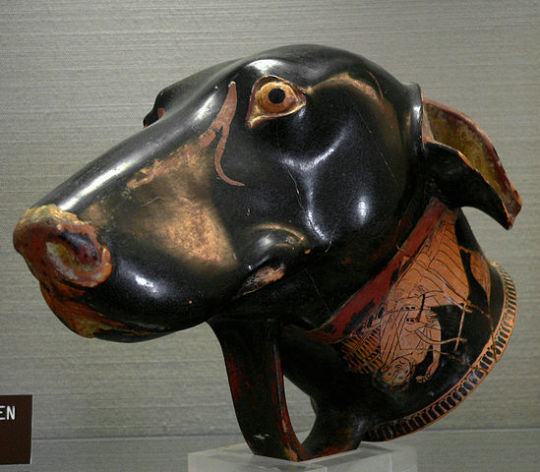
Some Pet Dog Names from Ancient Greece
When the hound has caught the hare, or been otherwise victorious in the course, you should […] pat him with your hand and praise him, kissing his head, and stroking his ears, and speaking to him by name […] for, like men of generous spirit, they love to be praised; and the dog, if not quite tired out [from the hunt] will come up with joy to caress you. (Arrian, On Coursing, XVIII Pg 116 trans. William Dansey)
As many dogs were hunting hounds or guard dogs in Ancient Greece, it followed that the naming convention was dependant on psychology; to name the dog something strong or skilful was to boast of the animals’ superiority to others of its breed, just as it reflected on the owner. There are some well known dogs in Ancient Greek history that many are aware of, namely Cerberus, Odysseus’ faithful dog Argos, and Alexander the Great named a city after his dog Peritas. We are lucky to have two lists of excellent dog names from authors Xenophon and Ovid.
From Xenophon (~ 430 - 355 BC), in his treaties on Hunting, we have the below list:
Give the hounds short names, so as to be able to call to them easily. The following are the right sort: Psyche, Thymus, Porpax, Styrax, Lonchê (Lance), Lochus, Phrura, Phylax (Sentinel/Guardian), Taxis, Xiphon, Phonax, Phlegon, Alcê (Stout), Teuchon, Hyleus, Medas (Crafty), Porthon, Sperchon (Bustler/Hasty), Orgê, Bremon, Hybris, Thallon (Vigorous), Rhomê, Antheus (Blossom), Hebe, Getheus, Chara (Jolly/Ecstasy), Leusson, Augo (Bright), Polys, Bia, Stichon, Spudê, Bryas, Oenas (Blueskin), Sterrus, Craugê, Caenon, Tyrbas, Sthenon, Aether, Actis, Aechmê, Noes (Counsellor), Gnomê, Stibon, Hormê (Impetus). (Xenophon Kynegetikos On Hunting 7.5)
A kind person on Reddit suggested these names could also translate as:
Psyche = Psyche / Spirit
Thymus = Pluck
Porpax = Buckler
Styrax = Spigot
Lonche = Lance
Lochus = Lurcher
Phrura = Watch
Phylax = Keeper
Taxis = Brigade
Xiphon = Fencer
Phonax = Butcher
Phlegon = Blazer
Alce = Prowess
Teuchon = Craftsman
Hyleus = Foster
Medas = Counsellor
Porthon = Spoiler
Sperchon = Hurry
Orge = Fury
Bremon = Growler
Hybris = Riot / Insolence
Thallon = Bloomer
Rhome = Rome / Mighty
Antheus = Blossom
Hebe = Hebe / Youth (Young’n)
Getheus = Hilary / Happy
Chara = Jollity
Leusson = Glazer
Augo = Eyesbright
Polys = Much
Bia = Force
Stichon = Trooper
Spude = Bustle
Bryas = Bubbler
Oenas = Rockdove
Sterrus = Stubborn
Crauge = Yelp
Caenon = Killer
Tyrbas = Strongboy / Riot
Sthenon = Sky
Aether = Sunbeam
Actis = Bodkin
Aechme = Wistful
Noes = Gnome
And from Ovid (~ 43 BC - 17 AD), in his Metamorphosis, of the dogs that attacked their master Actaeon, we have:
First ‘Black-foot’, Melampus, and keen-scented Ichnobates, ‘Tracker’, signal him with baying, Ichnobates out of Crete, Melampus, Sparta. Then others rush at him swift as the wind, ‘Greedy’, Pamphagus, Dorceus, ‘Gazelle’, Oribasos, ‘Mountaineer’, all out of Arcadia: powerful ‘Deerslayer’, Nebrophonos, savage Theron, ‘Whirlwind’, and Laelape, ‘Hunter’. Then swift-footed Pterelas, ‘Wings’, and trail-scenting Agre, ‘Chaser’, fierce Hylaeus, ‘Woody’, lately gored by a boar, the wolf-born Nape, ‘Valley’, Poemenis, the trusty ‘Shepherd’, and Harpyia, ‘Snatcher’, with her two pups. There is thin-flanked Sicyonian Ladon, ‘Catcher’, Dromas, ‘Runner’, ‘Grinder’, Canache, Sticte ‘Spot’, Tigris ‘Tigress’, Alce, ‘Strong’, and white-haired Leucon, ‘Whitey’, and black-haired Asbolus, ‘Soot’. Lacon, ‘Spartan’, follows them, a dog well known for his strength, and strong-running Aëllo, ‘Storm’. Then Thoos, ‘Swift’, and speedy Lycisce, ‘Wolf’, with her brother Cyprius ‘Cyprian’. Next ‘Grasper’, Harpalos, with a distinguishing mark of white, in the centre of his black forehead, ‘Black’, Melaneus, and Lachne, ‘Shaggy’, with hairy pelt, Labros, ‘Fury’, and Argiodus, ‘White-tooth’, born of a Cretan sire and Spartan dam, keen-voiced Hylactor, ‘Barker’ […] First ‘Black-hair’, Melanchaetes, wounds his back, then ‘Killer’, Theridamas, and Oresitrophos, the ‘Climber’, clings to his shoulder. (Ovid Metamorphoses III 206-233 trans. A S Kline)
Theoi has Brookes More’s translation which offers a few English variations on the names.
A few fun ideas to keep in mind if looking to name a new pet in Ancient Greek style.
For I have myself bred up a hound whose eyes are the greyest of grey; a swift, hard-working, courageous, sound-footed dog[…]. He is most gentle, and kindly-affectioned […] as soon as he catches sight of me, showing symptoms of joy, and again trotting on before me. […] He is the constant companion of whichever may be sick; and if he has not seen either of us for only a short time, he jumps up repeatedly by way of salutation, and barks with joy as a greeting. (Arrian, On Coursing, V Pg 78-80 trans. William Dansey)
🐶 Sources
Xenophon Kynegetikos
Arrian On Coursing
Ovid Metamorphoses III
Dog shaped Rhyton by the Brygos Painter in Aleria
87 notes
·
View notes
Text
And let’s not forget Depp’s well-established misogyny. He has defended Roman Polanski, befriended fellow alleged abuser Marilyn Manson and said the accusations against Harvey Weinstein were implausible because his wife wasn’t “some hairy-backed bitch.” His texts from early in his relationship refer to Heard as an “idiot cow," “filthy whore” and “worthless hooker.” One says, “I'll smack the ugly cunt around before I let her in, don't worry."
These are officially “jokes,” but other correspondence has a sharper tone. In an e-mail to Elton John (!), Depp described the mother of his children as “the French extortionist (ex-cunt).” Later texts refer to Heard as "flappy fish market," "cum guzzling whore" and “scumbag gold-digging cunt.”
Call it bias if you want, but I simply don’t find it difficult to believe that a troubled man with a history of drug problems and violent outbursts — not to mention all the entitlement that comes with being a beloved and wealthy movie star — brought that pattern into his marriage.
Source:
https://www.readthepresentage.com/p/johnny-depp-amber-heard?s=r
21 notes
·
View notes
Text
Taylor Swift headlining Glastonbury isn't outrageous; it's outrageous it took this long to invite her
By: Neil McCormick for The Telegraph Date: December 16th 2019

Oh dear, here we go again. Taylor Swift is headlining Glastonbury festival and some people are a bit upset because - let me see if I have got this right - she’s a girly girl who plays girly pop music. For girls. Or something like that.
The 30-year-old American pop star will close the 2020 festivities with a Sunday night set on the Pyramid Stage. Given that all 134,000 tickets sold out in half an hour in October before any artists had even been announced, you might think festival goers would be excited at the prospect of being entertained by one of the biggest musical superstars in the world right now, who has won 10 Grammys and was this year voted Artist of the Decade by the American Music Awards.
But apparently not.
On the reliably combustible Twitter, fans were threatening to eat their tickets and throw themselves out windows. A Twitter user answering to the handle @TheVillaDecree helpfully summed up the problem in one grammatically suspect tweet: ‘Where the proper modern rock?! Very disappointed.’
Where the proper modern rock, indeed?
There persists a strange notion in some quarters that Glastonbury is an ancient and venerable institution dedicated to the worship of men with guitars, and that to allow this hallowed stage to be trod upon by anything other than a hairy rock band is an act of spiritual sacrilege.
That was essentially what Noel Gallagher was trying to express back in 2008, when he objected to rap superstar Jay Z’s headline set on the grounds that “I’m not having hip hop at Glastonbury. It’s wrong.” But, of course, Jay Z performed a fantastic set for a huge audience and even amusingly played one of Noel’s Oasis songs to rub it in.
Last year, by universal critical and popular acclaim, the stand-out headline performance was delivered by another rapper, Stormzy. He made history as the first British black male to headline Glastonbury. It was treated as a historic moment. But as a representative of the music Britain actually listens to now, that helps shape and reflect the consciousness of the young people who most obsess over it, you could argue that Stormzy did not need Glastonbury as much as Glastonbury needed him. Because pop culture is ever-changing and a music festival as ambitious and wide-ranging as Glastonbury needs to change with it or be left behind. And this year Taylor Swift is very much part of that change.
Swift will be only the sixth female solo artist to ever headline Glastonbury festival. On its 50th anniversary. Think about that. A festival that has been running for five decades, with three major headliners each year, has only managed to make top billing space for a handful of women.
They were Suzanne Vega in 1989, Sinead O’Connor in 1990, Kylie Minogue in 2005, Beyoncé in 2011 and Adele in 2016. We should add to that list pop duo Shakespears Sister in 1992, rock band Skunk Anansie in 1999 (fronted by Skin) and Florence + The Machine in 2015 (with the proviso that Florence Welch only got the headline spot because American rock band the Foo Fighters pulled out).
If you really want to express outrage about something on Twitter, that might be a place to start. Women have been marginalised in music for as long as there has been a music business, and Glastonbury’s paucity of female headliners is just another reflection of that. I wonder how much of that has been caused by a bias against the very idea that there is a kind of female pop music that just isn’t worthy of the serious attention and reverence accorded men with guitars?
But pop is the sound of our times. Not modern rock. Not old school rock. Not rock at all. And female artists are making some of the most imaginative and adventurous pop music that has ever been heard. And right there at the head of the pack is Taylor Swift, a witty, emotional singer-songwriter who uses confessional, diaristic songcraft to turn the narratives of her life into huge anthems that have reverberated around the world.
She sells in multi-millions and streams in the billions. She has been among the top 10 touring artists worldwide this decade, which would suggest she knows how to put on a show. The question isn’t whether she deserves to be at Glastonbury, the question is why Glastonbury has taken so long to invite her?
She is going to smash it. And hopefully the next time a major female superstar deigns to grace Glastonbury festival with her presence, it will not be seen as something to moan about on social media, but just show-business as usual.
#fun read - plus maybe some of you don't have access to the full article =)#it was actually kinda funny to watch the reactions...#cause for every person moaning there's few asking ''great - are you selling your tickets then?'' lmao =)#this happens every year...it's getting boring by now... but it's a cool read because it emphasizes the inequality that's going on#I never actually looked into that before...#taylor swift#article#the telegraph#glastonbury 2020#june 28th 2020#lover era#lover tour#artist of the decade
237 notes
·
View notes
Text
This is actually very important to bring up, because as much as people don't like to admit it, the ambivalence towards (or outright disapproval of) cis-presenting, gender-conforming queer men in queer spaces does contribute to issues like alt-right radicalization.
It's something I noticed quite a few years ago, and thought it was a problem back then as well. Guys don't feel welcome in these spaces unless they're obviously flamboyant or gender non-conforming in some way.
For example, my roommate, a cis dude, is demisexual, and went through the exact same arc pretty much every person goes through when they realize they're queer: A period of questioning, the clarity of discovering there's a word for it, and the ordeal of coming out to family and friends. Now he's got the demi pride flag hanging in his room. But despite all this, he stays out of queer spaces because he feels like they're not his place at all.
I've also noticed queer people seem less receptive to trans dudes who are very masculine in their presentation and mannerisms—bald, bearded, hairy, the whole nine—as opposed to those who lean more androgynous or who otherwise pepper more gender-nonconformity into their presentation.
Even my own experiences relate, in a somewhat opposite way: My internal gender experience is very squarely "male," but I (intentionally) present more androgynous for "80's rockstar" reasons. However it seems like the queer communities I'm a part of will, more often than not, treat "gender-non-conforming man of trans experience" as interchangeable with "nonbinary transmasculine," when it's not.
Anyway, this is all to say there's a lot of small things that hint at a bias against having too much masculinity in queer spaces—specifically the kind of masculinity that reminds people of typical cis men. It's true there are plenty of reasons why AFAB individuals are cautious around this, but it's also true that it discourages queer cis dudes from joining in, which can turn them off to progressive spaces in general. Which is. Not great.
I think this is something that should be discussed more, and critically examined, within the queer community.
Still bothered by the US cultural idea that men can only be non-romantically intimate with one another in war-like or competitive circumstances.
91K notes
·
View notes
Text
20 Best Rogue & Gambit Covers (Part II)
Here’s the same stuff I said before:
For the hottest couple in the Marvel universe, there are surprisingly few truly great (and truly hot!) Rogue & Gambit covers to be published since the characters began flirting literal decades ago.
In the run up to our BIG RELEASE of Rogue & Gambit #1 on 1/3/18…and with a all of us aching for the lettered preview to drop, I thought I’d count down the 20 best Gambit & Rogue covers.
I AM including Kris Anka’s publicly released covers for our series in the running, even though they are not yet published…because…well, because this is the FIRST EVER ROGUE & GAMBIT COMIC AND HOW COULD I NOT???
If you think I missed something…it’s possible. But it’s also possible I’m just not a fan of that cover. To each their own as they say.
Most importantly…can anything we’ve seen yet beat the most iconic Rogue & Gambit cover of all time? (C’mon, you know the one!)
Anyway, here’s to A LOT MORE Gambit & Rogue hotness in our future and onto the list! :D
And HERE’S Covers #1 - #10!
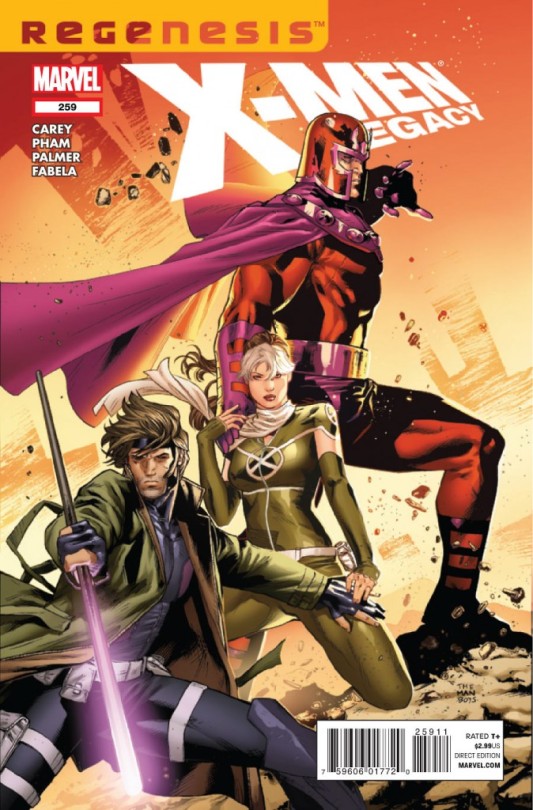
10. X-MEN LEGACY #259 - CLAY MANN. Absolutely gorgeous. Again, BIG points off for Rogue bringing another dude to the party, but this is gorgeously illustrated, has a ton of tension and heat. What Mann manages to do with just Magneto’s hand on Rogue’s shoulder and Gambit’s on Rogue’s thigh and her hands on both of theirs is...sorta awe inspiring? And the fact that she’s got her eyes locked on the reader just puts it over the top intensity wise. It’s ironic, because this loses points for including Magneto...and yet the things that make it work like gangbusters demand that Magneto be there...conundrum. I think what it really highlights is what a shame it is that we never got a hot canon Rogue & Gambit cover from Mann.
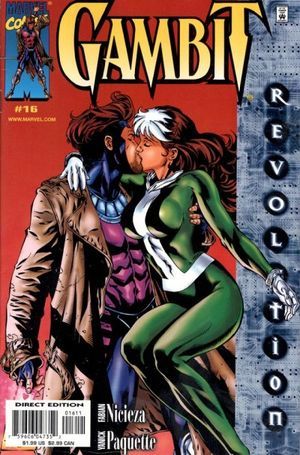
09. GAMBIT #16 - YANICK PAQUETTE. Finally THEY. ARE. KISSING. Omg. I can’t believe we had to get to #9 before we’ve got them actually kissing! AHHHH. So. This is a great illustration. Beautiful treatment of both Gambit and Rogue...I love the body language especially. And I don’t mind the minimalist red background - and it might even be intended as a call back to the red background on that iconic Rogue & Gambit cover (you know the one). The big problem with this has nothing to do with Paquette’s lovely work at all...it’s that hideous absolutely massive “storyline banner” that takes up more than a fifth of the entire cover. It honestly wrecks EVERYTHING and makes me furious tbh.
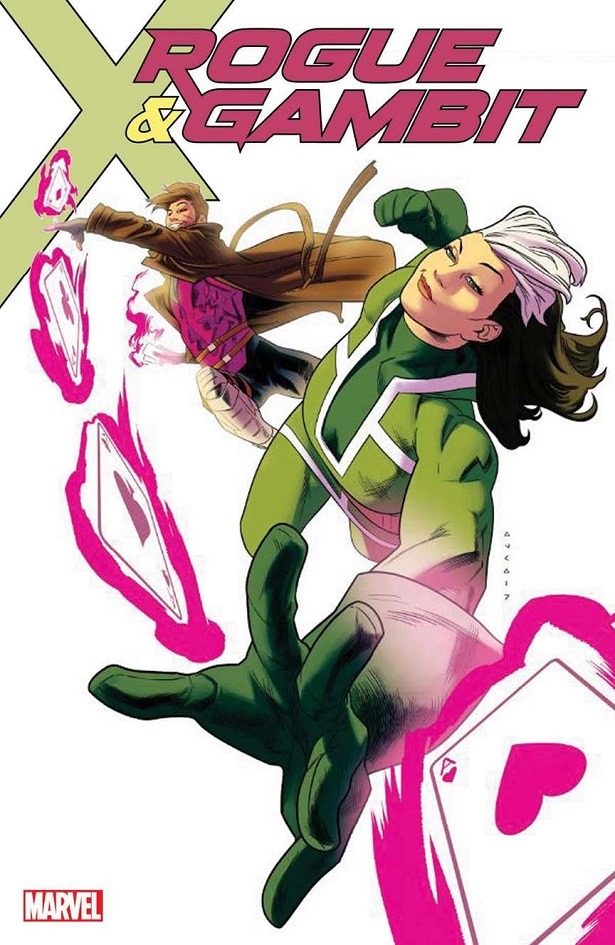
08. ROGUE & GAMBIT #1 - KRIS ANKA. Amazing energy and movement, love the confident use of white space, and the sassy attitude they both have in body language and expression. I am also a really big fan of the title block text as it is here...BUT that’s not how the final is going to look as it will have the “Marvel Legacy” trade dress...which is fine, but not as good as this. So slight points off there. I still like the actual “Rogue & Gambit” title block itself a lot. And the “Ring of Fire” part 1 text banner is small/high/unassuming, so it’s pretty good overall! You’ll see. And yes, I’m very biased here. Fully admit that. I’m a huge fan of Kris Anka’s work, he’s my friend, and this is my book. I come with ALL THE BIAS AND AM HAPPY TO ADMIT IT. ;D
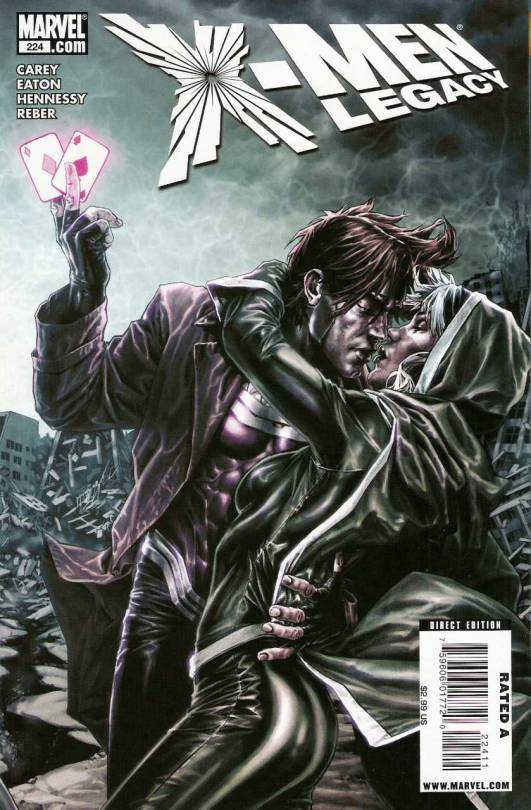
07. X-MEN LEGACY #224 - LEE BERMEJO. This is a little dark compared to what we’re used to seeing for these two in covers and a little more realistic than I tend to prefer...but I totally dig it. It’s got a ton of intensity, and the body language and expression work is awesome. They really feel almost about to kiss, which, if you’re not going to get the actual kiss, is quintessential Gambit and Rogue, right? The title block stuff is really simple and unassuming as well.
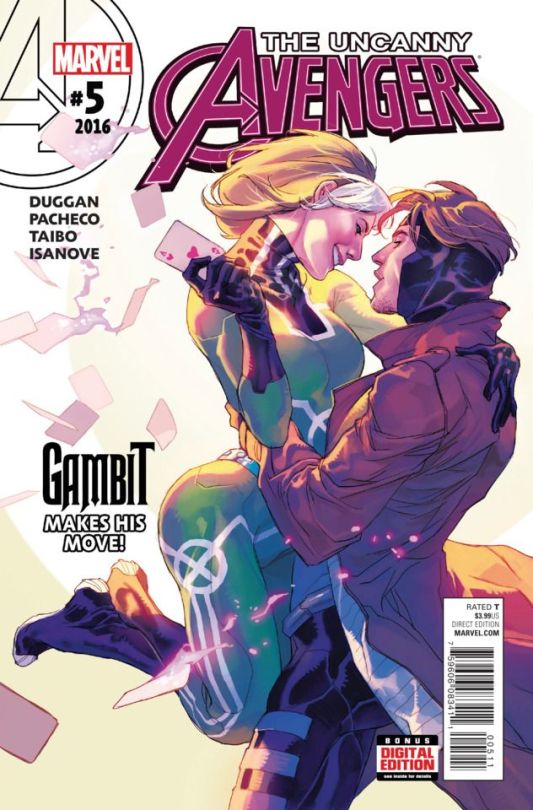
06. UNCANNY AVENGERS #5 - CARLOS PACHECO. A really nice homage to the accepted most iconic Rogue & Gambit image of all time...it doesn’t beat it, but it’s totally lovely. A gorgeous illustration that feels like that old cover, but nicely updated and its own thing. It loses points for a little bit too much text nonsense going on...and the expressions don’t QUITE work for me, plus I’ll never love Rogue with short hair ;D but all in all, a beautiful piece.
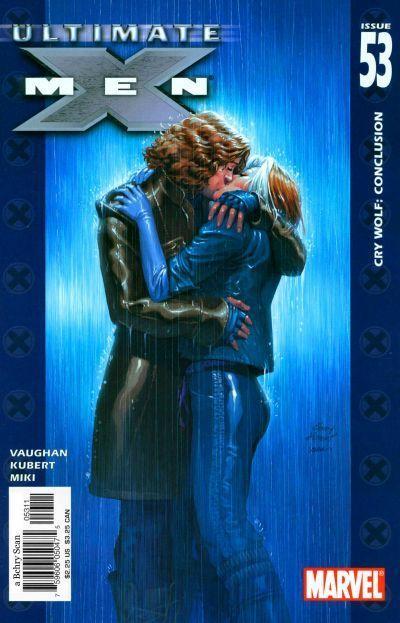
05. ULTIMATE X-MEN #53 - ANDY KUBERT. If you can believe it...this is the only other cover on the list (ever?) with an actual lip lock! Crazy. But at least it’s GORGEOUS. I really do love this one - the blue tones, the rain, the intensity, the simplicity, I just love it. It loses a few points for really dumb stuff though. I hate the blue borders with the X symbols (so dumb) and some slightly obnoxious title block/giant numbers stuff, but mostly...I just...really hate Remy’s hair? Yeah, it just doesn’t look like Gambit with that weird wavy hair. That’s honestly my biggest beef with this otherwise gorgeous piece.
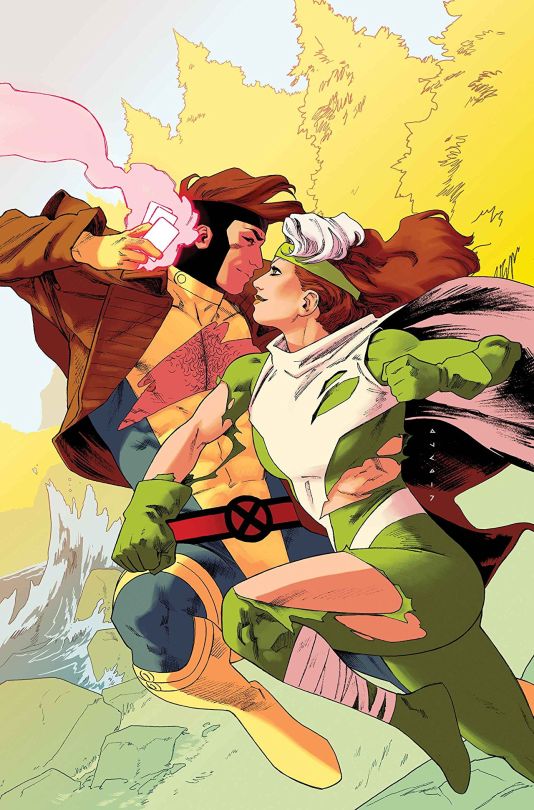
04. ROGUE & GAMBIT #2 - KRIS ANKA. Admittedly this is getting a bit of a pass for not having the title block on it, but since I know about what that will look like, I think I know enough to be okay with it. And I think people will love this cover even more when they see what’s inside the issue. But based on what we have here - it gets so many points for pure fun, plus it has great energy and movement. PLUS the obvious connection/chemistry between our leads. Bonus points for Rogue’s glorious thighs. Bonus points for Gambit’s conveniently torn uniform (and hairy chest). And Bonus points for Gambit’s perfect smirk! Again, noted that I’m highly biased...and I don’t care!
*runs away, fingers in ears*
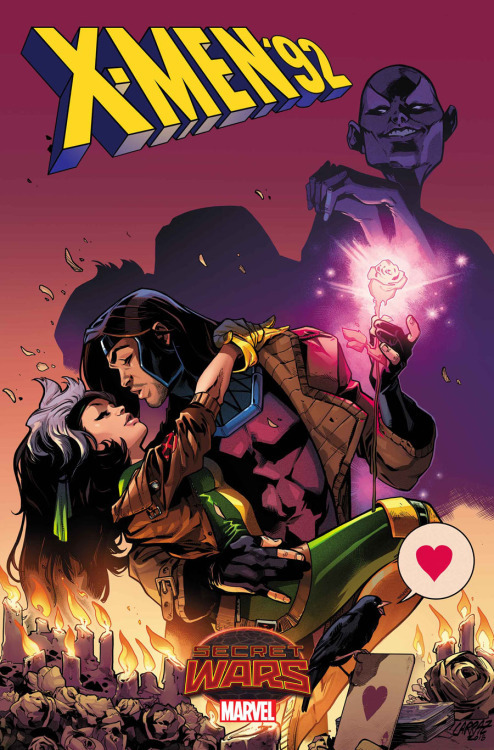
03. X-MEN 92 #2 - PEPE LARRAZ. So here’s how much I love this cover...I don’t buy print comics any more (no room!) just digital and then trades for some stuff for my shelves. But for this I went out and bought a print copy. Had to have this in my hands. I love everything about it. Well, okay, in a PERFECT world Cassandra isn’t in the background, but everything else is perfection. The swooning, the love, the drama, even the little raven with the “heart” word balloon. LOVE IT. And no surprise really because Pepe Larraz is a hell of an artist who went on to draw a spectacular Rogue (and sometimes Gambit) in Uncanny Avengers!
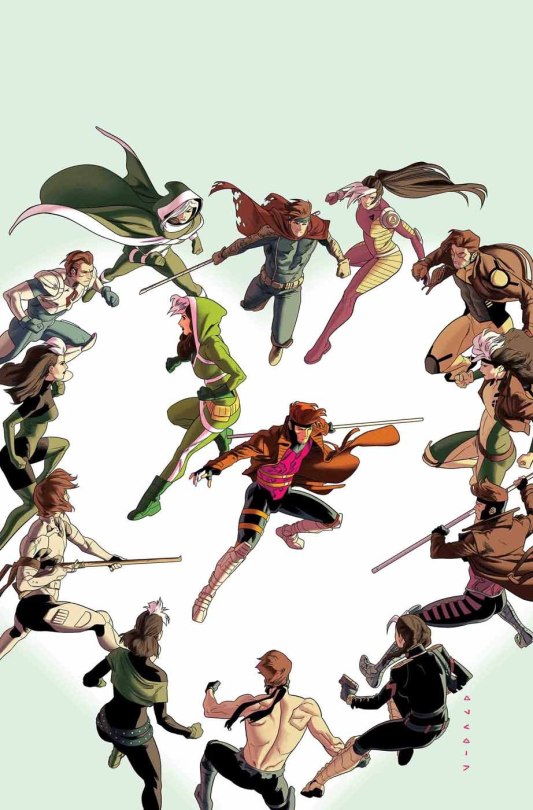
02. ROGUE & GAMBIT #3 - KRIS ANKA. So...there are great, beautifully illustrated covers...and then there are great, beautifully illustrated covers that are also PERFECTLY CLEVER and instantly become iconic. That’s this one for me. As if a dozen versions of Gambit and Rogue weren’t fun enough, the heart shape they make... *kisses fingers* ...it’s perfection. I wish nothing more than us not having to put ANY text on this. I wish we could just send it out as is. Alas, no. And that is gonna knock it down JUST ENOUGH to NOT unseat the iconic classic. (But maybe issue #4 or #5 will??? We still have time!) :D
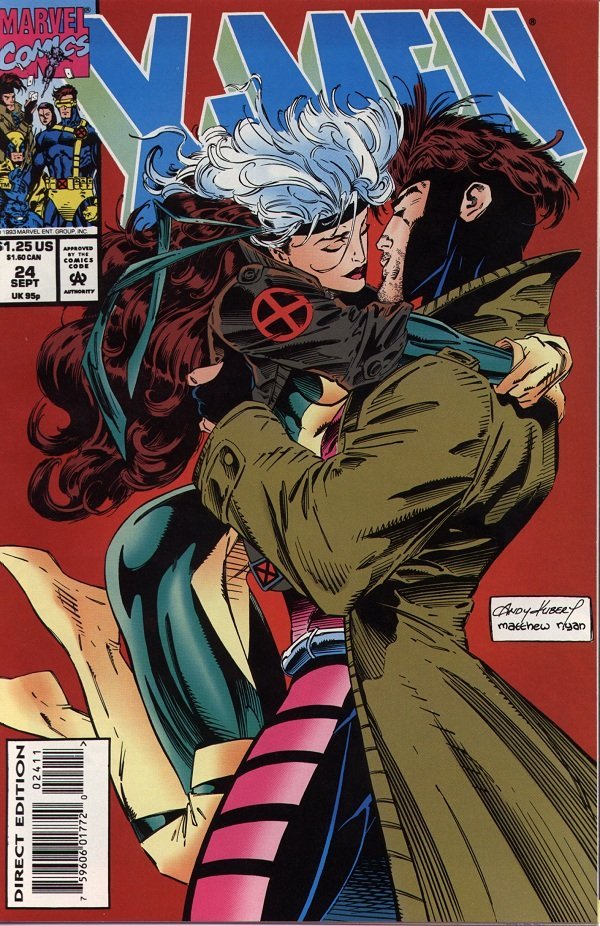
01. X-MEN #24 - ANDY KUBERT. It all comes down to this, as you knew it would. The classic cover that launched a thousand ships...or rather... CEMENTED them. It’s just gorgeous. It’s perfectly 90′s. It just BATHES in the nostalgia of classic Gambit and Rogue. it’s not afraid to cover up more than half the title block (YOU KNOW WHO THEY ARE, YOU DON’T NEED NO PESKY TITLE BLOCK!). That it rocks the most classic, well-known, and beloved looks for both of them only cements things further. And because they were still doing the “no touching dance” in these early days...their state of almost touching is just...PALPABLE. I’ll also say that though Rogue’s face gets the focus, Gambit is just really lovingly rendered too.
HOTT.
So. There you have it. My picks for the 20 Best Rogue & Gambit covers of all time.
Don’t forget to hit up your LCS on Wednesday 1/3/18 (or Comixology) for Rogue & Gambit #1 and keep reading to see if we (ahem, KRIS ANKA) can unseat the 20+ year title holder of “Best Rogue & Gambit Cover of All Time”
No pressure, Kris! :D
460 notes
·
View notes
Link
Stress is a universal physiological response experienced by every person in the world. Stress has become a word that we automatically associate with negative connotations, and in today's health-driven society, this word has become a variable boogeyman
0 notes
Note
Two quick questions, do you think anything will happen with the Blackwoods Weirwood, and who do you think is in the right concerning the Bracken vs Blackwood feud?
I don’t think anything will happen with the weirwood of Raventree Hall? I mean, it’s very dead, and has been for a thousand years. Though I could imagine a neat scene where Bran reaches out with his powers and all the hundreds of ravens that nest on the weirwood all fly off at once, quorking some message of doom. And maybe, maybe the long-dead white tree would put forth leaves, whether every branch at once or just one single red leaf? It’s a fascinating image (and lbr half my endgame predictions are based on how cool they would look), but I really have no proof that it would ever happen.
Although I do think that the Blackwood godswood is very probably the place where Aegon V proposed to Betha. So even if the Raventree weirwood never appears again in main ASOIAF, it should have a neat appearance or two in some Dunk and Egg stories. :)
As for the Brackens and Blackwoods, they’re both in the wrong, that’s the whole point.
“How did all this begin, between Blackwood and Bracken? Is it written down?”“It is, my lord,” the boy said, “but some of the histories were penned by their maesters and some by ours, centuries after the events that they purport to chronicle. It goes back to the Age of Heroes. The Blackwoods were kings in those days. The Brackens were petty lords, renowned for breeding horses. Rather than pay their king his just due, they used the gold their horses brought them to hire swords and cast him down.”“When did all this happen?”“Five hundred years before the Andals. A thousand, if the True History is to be believed. Only no one knows when the Andals crossed the narrow sea. The True History says four thousand years have passed since then, but some maesters claim that it was only two. Past a certain point, all the dates grow hazy and confused, and the clarity of history becomes the fog of legend.”Tyrion would like this one. They could talk from dusk to dawn, arguing about books. For a moment his bitterness toward his brother was forgotten, until he remembered what the Imp had done. “So you are fighting over a crown that one of you took from the other back when the Casterlys still held Casterly Rock, is that the root of it? The crown of a kingdom that has not existed for thousands of years?” He chuckled. “So many years, so many wars, so many kings… you’d think someone would have made a peace.”“Someone did, my lord. Many someones. We’ve had a hundred peaces with the Brackens, many sealed with marriages. There’s Blackwood blood in every Bracken, and Bracken blood in every Blackwood. The Old King’s Peace lasted half a century. But then some fresh quarrel broke out, and the old wounds opened and began to bleed again. That’s how it always happens, my father says. So long as men remember the wrongs done to their forebears, no peace will ever last. So we go on century after century, with us hating the Brackens and them hating us. My father says there will never be an end to it.”
–ADWD, Jaime I
The feud of the Blackwoods and Brackens is infamous, and rightly so, for it stretches back thousands of years to before the coming of the Andals. The origins of it are contested and shrouded in legend. The Blackwoods say they were kings and the Brackens little more than petty lords set on betraying and deposing them, while the Brackens say much the same about the Blackwoods. That they were both royal houses on the Trident seems true enough, and none can doubt that their enmity sprang from some cause, so entrenched that it has become legendary. Powerful as they were, they have maintained their feud despite the many kings who have attempted to make a peace between them. –The World of Ice and Fire
I mean, I slightly lean more to the Blackwood side, but I’m perfectly aware it’s because of GRRM’s narrative bias and my aesthetic preferences. The Blackwoods are tall, willowy and have colors of black, white, and red (so goth, so favorite), the Brackens are brutish and hairy and have colors of yellow and brown (urine and feces), when the Andals came the Blackwoods stayed Old Gods worshippers whereas the Brackens converted to the Faith, the Blackwoods were on the Black side in the Dance of the Dragons and the Red in the Blackfyre Rebellion whereas the Brackens were on the Green and Black, after the Red Wedding the Blackwoods stayed loyal to the Starks whereas the Brackens went immediately over to the Lannisters, and I’ll take sweet Melissa over conniving Barba (poor groomed Bethany though) and mysterious sinister wizard Bloodraven over angry resentful warrior Bittersteel any day. (re the last, I always have to rec @racefortheironthrone’s Conan and Elric parallels meta.)
Still, just because I prefer House Blackwood, I’m not going to let it affect my feelings over the feud, it’s for sure “a plague o’ both your houses” situation as literary family feuds always are. Though in the eventual D&E story where the village of Pennytree is made a royal fief (possibly the story codenamed The Village Hero, possibly another), I thoroughly expect GRRM to make us dislike the Brackens even more. But he may surprise us, and balance out his narrative bias re the feud, you never know. Mind you, with the way the Brackens have been depicted so far, I will be very surprised if he does. ;)
#lookatallthesetakenurls#asoiaf#asoiaf meta#weirwoods#raventree hall#house blackwood#my house!#house bracken#the blackwood-bracken feud#asoiaf speculation#bran stark#dunk and egg#the village hero#tbh half my endgame speculation is for the aesthetic
113 notes
·
View notes
Text
SOC 120 Blog 5: We Are Not a Wave, We Are the Ocean
What the heck is a "wave" of feminism? The "first wave" secured women's right to vote. The second gave us access to abortion. Now we're in the third wave and we're doing trans rights. Right? It's more complicated than that. As Constance Grady wrote for Vox in 2018:
The wave metaphor can be reductive. It can suggest that each wave of feminism is a monolith with a single unified agenda, when in fact the history of feminism is a history of different ideas in wild conflict.
It can reduce each wave to a stereotype and suggest that there’s a sharp division between generations of feminism, when in fact there’s a fairly strong continuity between each wave — and since no wave is a monolith, the theories that are fashionable in one wave are often grounded in the work that someone was doing on the sidelines of a previous wave. And the wave metaphor can suggest that mainstream feminism is the only kind of feminism there is, when feminism is full of splinter movements.
And as waves pile upon waves in feminist discourse, it’s become unclear that the wave metaphor is useful for understanding where we are right now. “I don’t think we are in a wave right now,” gender studies scholar April Sizemore-Barber told Vox in January. “I think that now feminism is inherently intersectional feminism — we are in a place of multiple feminisms” (Grady, 2018).
So with the understanding that this framework is kind of reductive, let's surf these supposed "waves" a little.
The first wave (1848 to 1920) did indeed centre around women's suffrage for the right to vote. Suffragettes were originally abolitionists, but then got mad when Black men—former slaves—got the vote before them, and Black women were often barred from or forced to walk behind white women during suffrage marches. Margaret Sanger opened the birth control clinic that would become Planned Parenthood during this wave. Women also worked to secure equality in education and employment, though there was a double standard when it came to women in the workplace; Black and brown women were considered less ladylike and more capable of labour, while white women were protected by the white men who held power, considered delicate and expected to stay in the home and raise children. There's some of those differing agendas within the movement.
The second wave (1963 to the 1980s) was called such because it had seemed that feminist activity had died down until Betty Friedan published The Feminine Mystique in '63, sparking a new "wave" of feminist activity. She talked about "the problem that has no name," which was that white middle-class women's "place" was in the home and they were being pathologised if they didn't like being stuck doing housework and childcare.
The Feminine Mystique was not revolutionary in its thinking, as many of Friedan’s ideas were already being discussed by academics and feminist intellectuals. Instead, it was revolutionary in its reach. It made its way into the hands of housewives, who gave it to their friends, who passed it along through a whole chain of well-educated middle-class white women with beautiful homes and families. And it gave them permission to be angry (Grady, 2018).
The phrase "the personal is political" comes from this time; the idea that small things that can seem like individual problems are actually a result of systemic oppression. Systemic sexism is defined as "the belief that women’s highest purposes were domestic and decorative, and the social standards that reinforced that belief" (Grady, 2018). Other things that were fought for during this time include equal pay; access to birth control (and an end to forced sterilisation of Black and disabled women); educational equality; Roe v. Wade and the right to have consensual abortions; political independence rather than being legally subordinate to husbands; working outside the home (for white middle-class women); awareness of and an end to domestic violence and sexual harassment. Some of the same things that women of the first wave were fighting for. Black feminists, however, were starting to get tired of white people obliviously hogging all the limelight; bell hooks "argued that feminism cannot just be a fight to make women equal with men because not all men are equal in a capitalist, racist, homophobic society" (University of Massachusetts, 2017). This started the tradition of Black feminist thought and womanism.
The third wave, starting in the 1990s and inspired by work in the 80s, embraced a lot of stuff that the second wave rejected.
In part, the third-wave embrace of girliness was a response to the anti-feminist backlash of the 1980s, the one that said the second-wavers were shrill, hairy, and unfeminine and that no man would ever want them. And in part, it was born out of a belief that the rejection of girliness was in itself misogynistic: girliness, third-wavers argued, was not inherently less valuable than masculinity or androgyny (Grady, 2018).
In this time we had the riot grrrl phenomenon on the music scene; the continuation of the fight that started in the 80s for access to medical treatment for HIV/AIDS and the humanisation of queer people; queer politics which emphasise that there are more types of queers than just middle-class white gay men and lesbians; sex-positive feminism advocating for sexual liberation and consent; and transnational feminism, which "highlights the connections between sexism, racism, classism, and imperialism" (University of Massachusetts, 2017). Kimberlé Crenshaw's coining of the term "intersectionality" in the 80s to refer to the intersections between different kinds of oppression (woman AND Black, woman AND disabled, woman AND immigrant, etc.), became the name of the game.
Arguably, we are now in a fourth wave of feminism, an online wave, which "is queer, sex-positive, trans-inclusive, body-positive, and digitally driven" (Grady, 2018). We use hashtags like #MeToo on Twitter and we organise SlutWalks online and we circulate our revolution magazines with hyperlinks rather than paper. We don't have to attend a rally in order to make our presence known, and we don't have to leave the house and gather together in person in order to hear each other's stories and energise each other to act. We're enabled to be lazier, but we're also enabled to do something with minimal energy when we don't have very much due to a medical condition or other disability. We don't have to exhaust ourselves after work by driving or walking to another meeting place, we only have to log on. We face less physical danger online than we do on the streets. We're empowered in different ways than our predecessors were, and we have access to information and audiences in a way they could never have dreamed of.
I won't go into too much detail about the conflicts between generations or "waves" of feminism like Grady does in her Vox article. There will always be squabbling amongst group members. There will always be splinter movements off of the "mainstream" effort. The focus should be on the goal that we all share, that of ending some kind (or all kinds) of oppression. We should be helping each other to achieve that goal and promote real equality, not letting ourselves be divided along temporal, generational, racial, gender, or any other kind of lines. Coalitional feminism is essential—"politics that organizes with other groups based on their shared (but differing) experiences of oppression, rather than their specific identity"—the opposite of identity politics, which revolve around one identity at a time (University of Massachusetts, 2017).
Unity can be difficult when some groups consider their aims fundamentally at odds, but tearing each other down rather than working to tear down the walls that separate the marginalised from the mainstream is just wasted energy. So while the wave structure can be useful when talking about different "main" events in the historical record of feminist activism, ultimately it just attempts to neatly compartmentalise something that has always been vast and complex and noisy. Feminism's nuances are part of its legacy. If there is anything that all feminisms have in common, it is that we have always been a thorn in the side of the establishment.
Vox as a media corporation is a bit left-leaning, but feminism also tends to be left-leaning. Their niche is in explaining political and social goings-on to a lay-public who may not be keeping up with all the news regarding any given topic. Their sources are credible and their reliability is rated highly by Ad Fontes Media and Media Bias/Fact Check.
[1,432 words]
Grady, C. (2018, July 20). The waves of feminism, and why people keep fighting over them, explained. Vox. https://www.vox.com/2018/3/20/16955588/feminism-waves-explained-first-second-third-fourth
“Introduction to Women, Gender, and Sexuality Studies” by University of Massachusetts, 2017. CC BY Creative Commons Attribution 4.0.
(http://openbooks.library.umass.edu/introwgss/)
0 notes